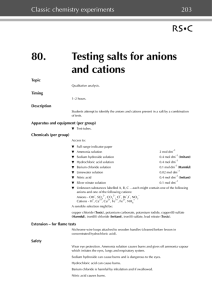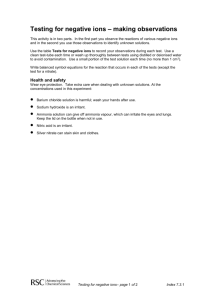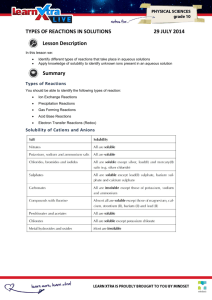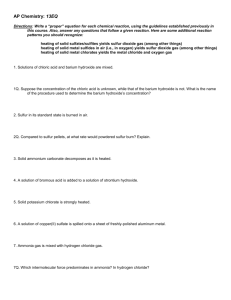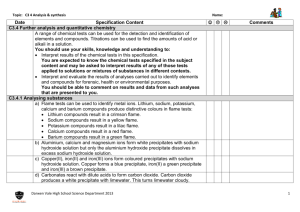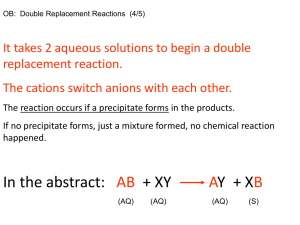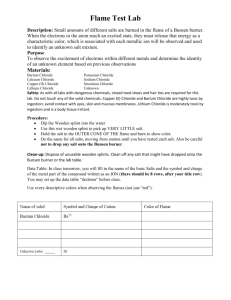Unknown Compound Ide..
advertisement
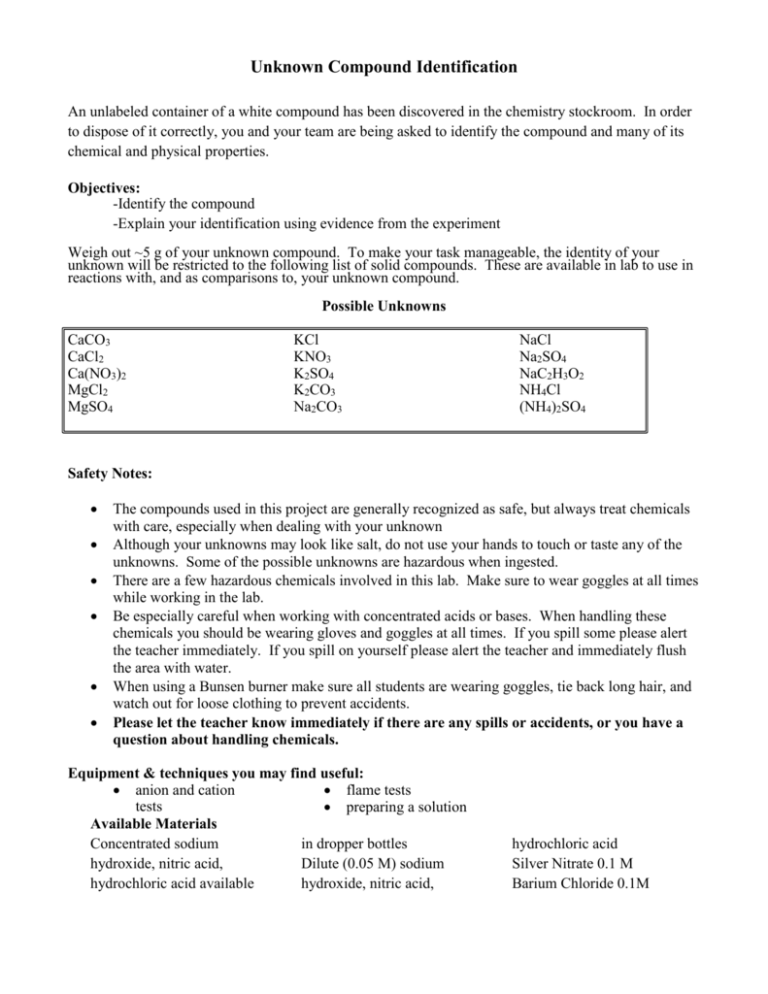
Unknown Compound Identification An unlabeled container of a white compound has been discovered in the chemistry stockroom. In order to dispose of it correctly, you and your team are being asked to identify the compound and many of its chemical and physical properties. Objectives: -Identify the compound -Explain your identification using evidence from the experiment Weigh out ~5 g of your unknown compound. To make your task manageable, the identity of your unknown will be restricted to the following list of solid compounds. These are available in lab to use in reactions with, and as comparisons to, your unknown compound. Possible Unknowns CaCO3 CaCl2 Ca(NO3)2 MgCl2 MgSO4 KCl KNO3 K2SO4 K2CO3 Na2CO3 NaCl Na2SO4 NaC2H3O2 NH4Cl (NH4)2SO4 Safety Notes: The compounds used in this project are generally recognized as safe, but always treat chemicals with care, especially when dealing with your unknown Although your unknowns may look like salt, do not use your hands to touch or taste any of the unknowns. Some of the possible unknowns are hazardous when ingested. There are a few hazardous chemicals involved in this lab. Make sure to wear goggles at all times while working in the lab. Be especially careful when working with concentrated acids or bases. When handling these chemicals you should be wearing gloves and goggles at all times. If you spill some please alert the teacher immediately. If you spill on yourself please alert the teacher and immediately flush the area with water. When using a Bunsen burner make sure all students are wearing goggles, tie back long hair, and watch out for loose clothing to prevent accidents. Please let the teacher know immediately if there are any spills or accidents, or you have a question about handling chemicals. Equipment & techniques you may find useful: anion and cation flame tests tests preparing a solution Available Materials Concentrated sodium in dropper bottles hydroxide, nitric acid, Dilute (0.05 M) sodium hydrochloric acid available hydroxide, nitric acid, hydrochloric acid Silver Nitrate 0.1 M Barium Chloride 0.1M Ammonia Solutions Solid KCl, CaCl2, MgCl2, NaCl Unknown substances labeled A, B, C,D containing one of the following anions and cations: Anions: CO3-2, Cl-, NO31 ,SO4-2, C2H3O2Cations (Ca+2, Mg+2, Na+, NH4+, K+) Bunsen burner Wire loops (for flame tests) pH probe pH paper conductivity probe large test tubes Erlenmeyer flasks and Beakers (50, 150, 250 mL) pipets weighing paper Procedure Part I: Creating Solution of your solid 1. Obtain ~5g of your designated sample (A, B, C or D) from your teacher. 2. Dissolve 1 g of your unknown substance in deionized water in a 250 mL beaker. 2040ml of water may be needed. 3. You will be conducting tests with small amounts (1-2 mL) of your solution. 4. Tests are divided up into a cation test (Part II), and anion tests (Part III). 5. After determining your cation and anion you should be able to identify your unknown solid. Part II. Cation Test (Flame Test) 1. Measure about 5mL of unknown solution into a graduated cylinder. 2. Pour the solution into a test tube. 3. Clean the loop: Heat the wire loop in the outer edge of the Bunsen burners flame, keep doing that till no color is in the flame. 4. Dip the clean wire loop into your unknown solution. 5. Move the loop up and down in the outer edge of the flame. Record the color of the flame shown. 6. If you have extra time after identifying the complete formula, you may want to repeat this test using one of the known compounds that has the same cation as you predicted. You can then compare the color this produces to the color of your unknown. Part III. Anion Tests You will be conducting three different tests to identify your anion. You will be reacting a solution of your unknown with Silver Nitrate, Barium Chloride, and Hydrochloric Acid. A. Silver Nitrate with Ammonia 1. Add a few drops of dilute nitric acid (careful this is an irritant) followed by a few drops of silver nitrate solution). 2. Does a precipitate form? If so, what color is it? Record your results. 3. If a precipitate formed, add dilute ammonia solution to the precipitate. Does the precipitate dissolve? Record your results. 4. If dilute ammonia solution does not help your solid dissolve try adding more concentrated ammonia solution. Does the precipitate dissolve? Record your results. B. Barium Chloride 1. Go to your teacher and have them add a few drops of Barium Chloride to solution. (Be careful barium chloride is very toxic). 2. Does a precipitate form? Record your observations and results on the data table. C. Hydrochloric acid 1. Add 3-4 drops of dilute hydrochloric acid to solution and record your observations. Data Table: Test Flame Test Results and Observations Silver Nitrate with Ammonia Test Barium Chloride Hydrochloric acid Data Interpretation Cation test (Flame Test Colors) The flame test is used to visually determine the identity of an unknown metal or metalloid ion based on the characteristic color the salt turns the flame of a bunsen burner. The heat of the flame excites the electrons of the metals ions, causing them to emit visible light. Every element has a signature emission spectrum that can be used to differentiate between one element and another. Metal Ion Color of flame +2 Ca Orange-red Mg+2 No color + K Violet Na+ Yellow + NH4 No color Anion Tests Test Anion Chloride (Cl–) Test and Observation Add a few drops of dilute nitric acid (Irritant) followed by a few drops of silver nitrate solution. A white precipitate of silver chloride is formed. The precipitate is soluble in ammonia solution. Bromide (Br–) Add a few drops of dilute nitric acid (Irritant) followed a few drops of silver nitrate solution. A pale yellow precipitate of silver bromide is formed. The precipitate is slightly soluble in ammonia solution. Iodide (I–) Add a few drops of dilute nitric acid followed by a few drops of silver nitrate solution. A yellow precipitate of silver iodide is formed. It is insoluble in ammonia solution. Add a few drops of barium chloride solution (Toxic) Barium chloride followed by a few drops of dilute hydrochloric acid. A white precipitate of barium sulfate is formed. Add dilute hydrochloric acid to the solution (or add it to Hydrochloric acid the solid). Bubbles of carbon dioxide are given off. Silver Nitrate with Ammonia Test Barium Chloride Sulfate (SO42–) Hydrochloric acid Carbonate (CO32–) Conclusion Questions 1. Which tests or reactions did you use to identify your unknown? 2. Based on the results of this test what is the cation? What evidence do you have to support this? 3. Based on the results, what is the anion? What evidence do you have to support this? 4. How does each part of your proecedure (pH test, flame test, reactions, etc.) help to identify your unknown? Please explicitly describe how each set of data you collected contributed to finding your unknown. 5. Please write the name and molecular formula for your unknown compound: 6. How certain are you of your groups identification of the unknown? If you are not certain of your groups identification what do you think are possible identities of your unknown? 7. What could you have done to be more certain in your identification of your unknown? 7. Can we ever be sure of the identity of the unknown?

